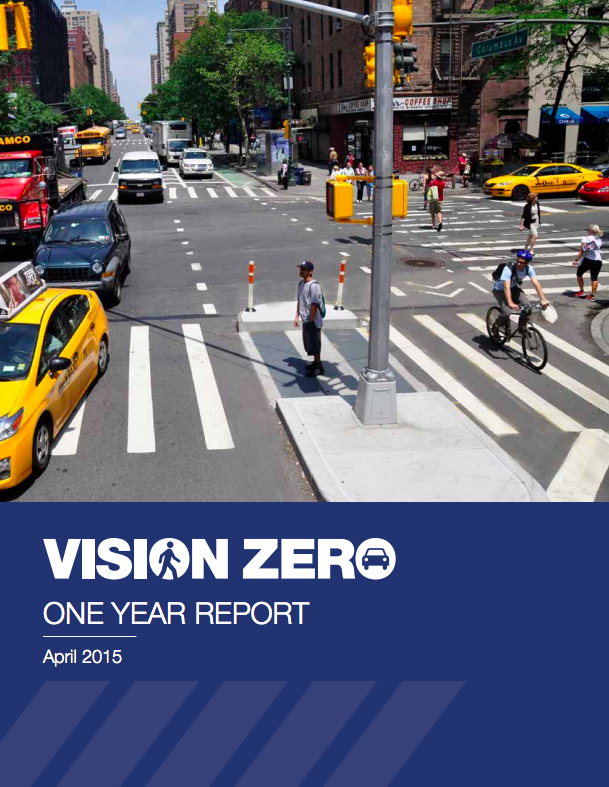Earlier this week, City Hall released an update on the first year of Vision Zero [PDF]. With 90 pages of charts, stats, maps, and graphs, it's impressively long. But how well does it measure the impact of the city's street safety policies?
There were a slate of changes to speed limits and traffic enforcement priorities in 2014, and it looks like these policies had an effect: Pedestrian fatalities reached an historic low last year. There should be enough data by now to draw some conclusions about what's working and what's not -- conclusions that can help guide Vision Zero policy going forward. But the report is mostly an exercise in checking off boxes.

Here are five key questions left unanswered by the report:
- Do Arterial Slow Zones work? Before securing state approval to lower NYC's default speed limit, the city established 27 "Arterial Slow Zones" -- major corridors that received 25 mph speed limits and focused enforcement from NYPD. Some of these changes have been in place for a year, but we still don't know the effect on key metrics like injury rates, crash severity, and the prevalence of speeding.
- How are speed cams affecting crashes and injuries? There are 63 school zone speed cameras on the ground right now, according to DOT, with 42 at fixed locations and 21 mobile units. The full 140 allowed by Albany will be installed by the end of this year. Studies from other cities have proven that speed cams work to slow drivers and reduce crashes, so what is the effect in New York City, where state legislation limits where and when cameras can operate? The Vision Zero update notes that speeding has declined 59 percent at 19 camera locations but provides no analysis of the impact on crashes or injuries. In February, WNYC put together a deeper look at the effect of speed cams than the city's own report.
- Are TLC-licensed drivers causing fewer injuries and deaths? The report says the de Blasio administration will seek a state law requiring seat belt use for front-seat passengers and children in taxis, but it doesn't have much data about actual taxi crashes. The Taxi and Limousine Commission fact book once included an entire section on crashes, analyzing everything from seatbelt use to the number of pedestrians and cyclists injured. An update more than a year ago neglected to mention crash data, and the Vision Zero update doesn't talk about the safety record of TLC-licensed drivers either.
- What about the rest of the city fleet? The Department of Citywide Administrative Services has a nifty new database tracking crashes across the city fleet, but that information is missing in the Vision Zero update. Has the city improved the safety record of its fleet under Vision Zero? We don't know, and this latest report didn't tell us.
- Where is NYPD concentrating its enforcement? Enforcement of dangerous violations like failure to yield and speeding increased last year. But are those tickets going to drivers at dangerous locations, and can we discern the impact of NYPD enforcement on crash and injury rates? There's no way to tell, because the city doesn't publish geographic data on traffic enforcement more detailed than the the precinct level.
There is some new information in the Vision Zero update, though it's more like factoids than analysis:
- More speed guns, but mostly for highway units: There are now 88 LIDAR speed guns distributed among NYPD's 77 precincts, and 138 among the department's four highway units. The report does not indicate whether the highway units were also assigned to local streets.
- Collision investigations still leave many victims behind: There were 255 traffic fatalities and thousands of severe injuries last year, yet NYPD's Collision Investigation Squad responded to just 430 crash scenes, the report says. CIS determined "criminality" in 96 of those cases, including 12 where CIS recommended charges under the Right-of-Way Law after it went into effect in August.
- Coordinating traffic enforcement with other crime deterrence: NYPD is looking into increasing enforcement of both traffic violations and non-traffic criminal summonses "in areas where both crime rates and traffic fatalities and injuries are high." (An example of this is Operation S.L.A.T.E. in Prospect-Lefferts Gardens and Wingate last November.)
- Using civilian NYPD personnel: NYPD will begin sending traffic enforcement agents to respond to crashes that do not result in injuries. The department will also begin training civilian staff to assist officers in processing blood-alcohol tests. In addition, auxiliary officers have already begun setting up "mock speed enforcement zones," in which uniformed civilians use radar guns but do not issue tickets.
This year, according to the report, NYPD will launch "a major technological upgrade" to better track crashes and enforcement. And for the first time, the city Department of Health will link crash records with injury information from hospital records to analyze which types of crashes cause particular injuries.
So the quality of data available to the city should improve. But if the city isn't publishing the data already at its disposal, what good will that do?





